

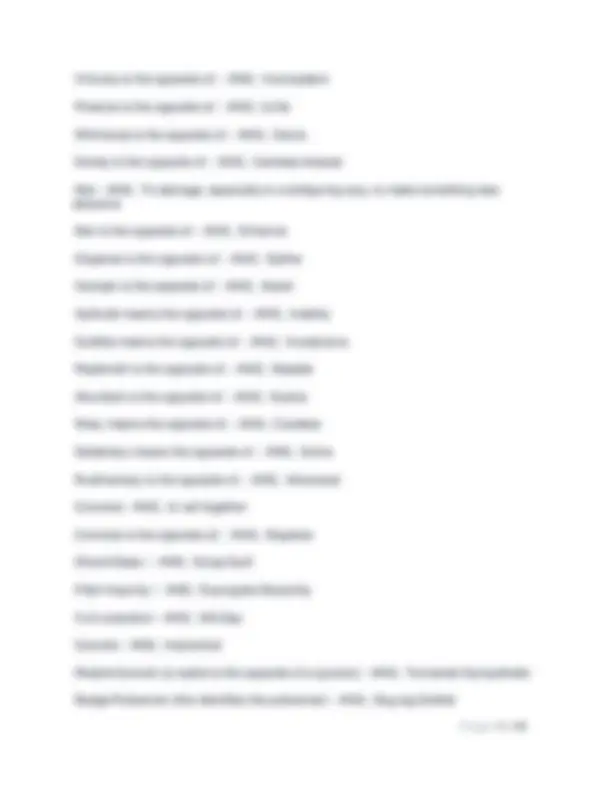
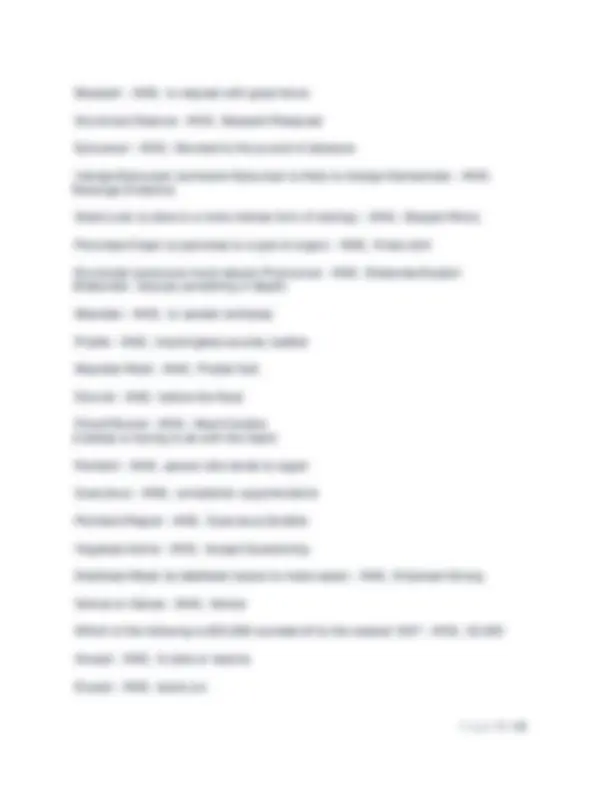
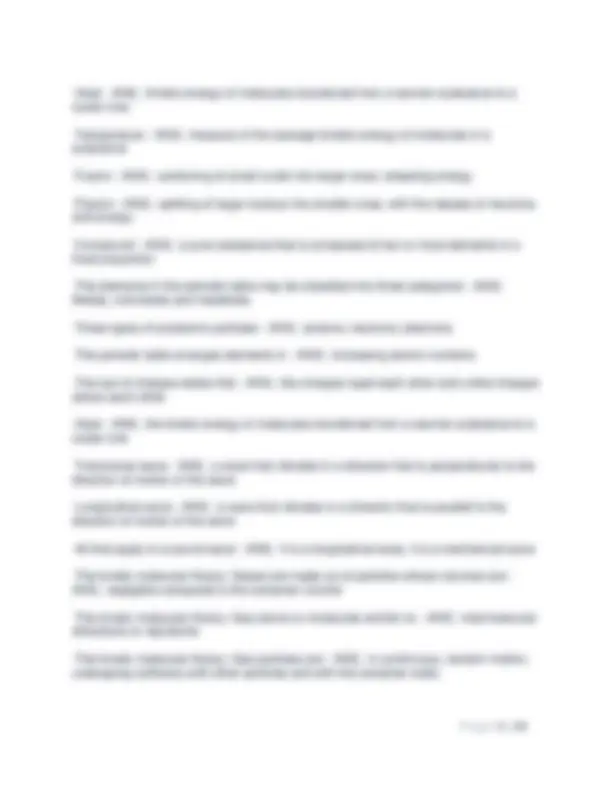
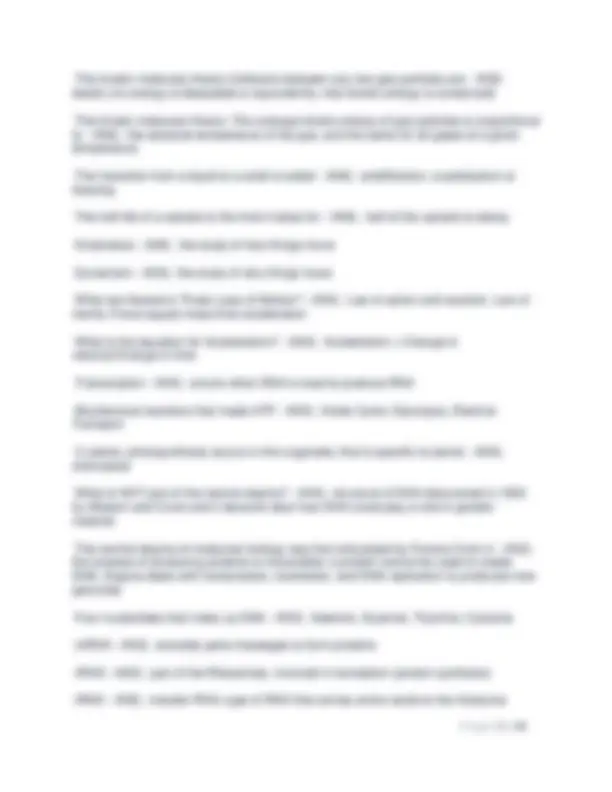
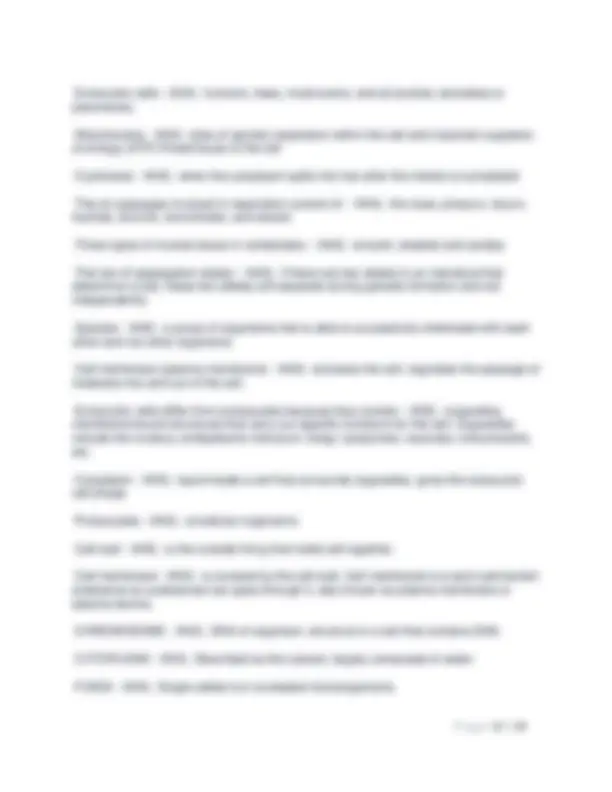
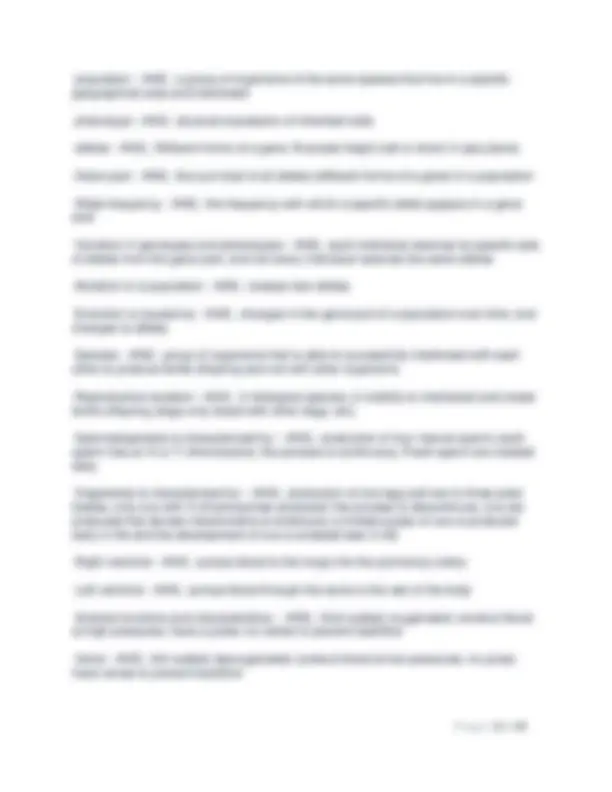
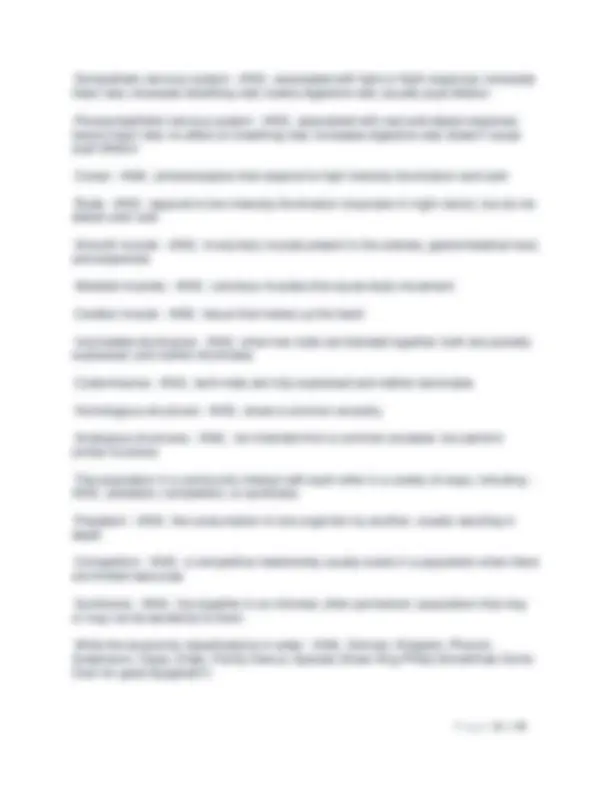
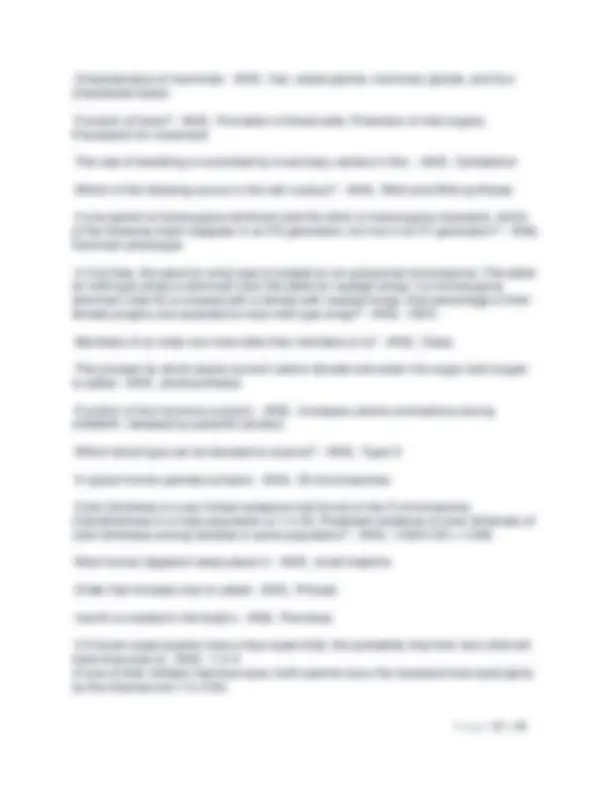
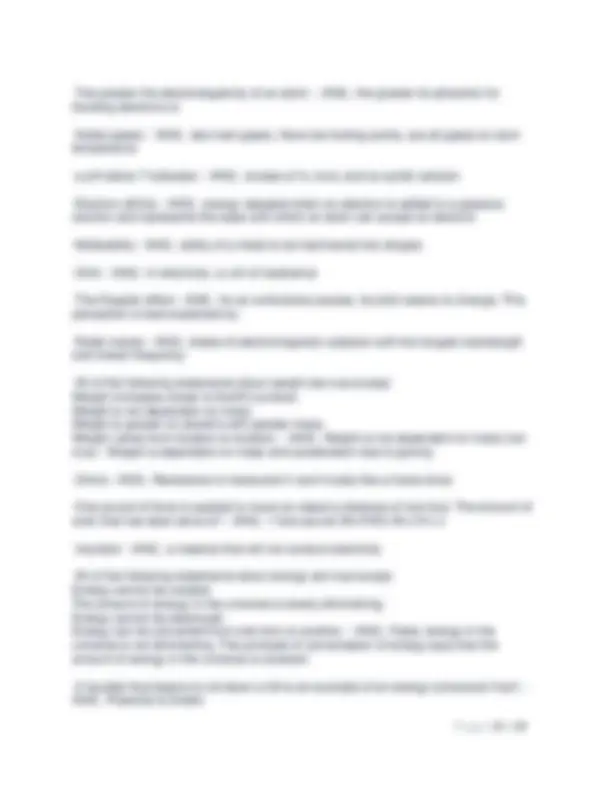
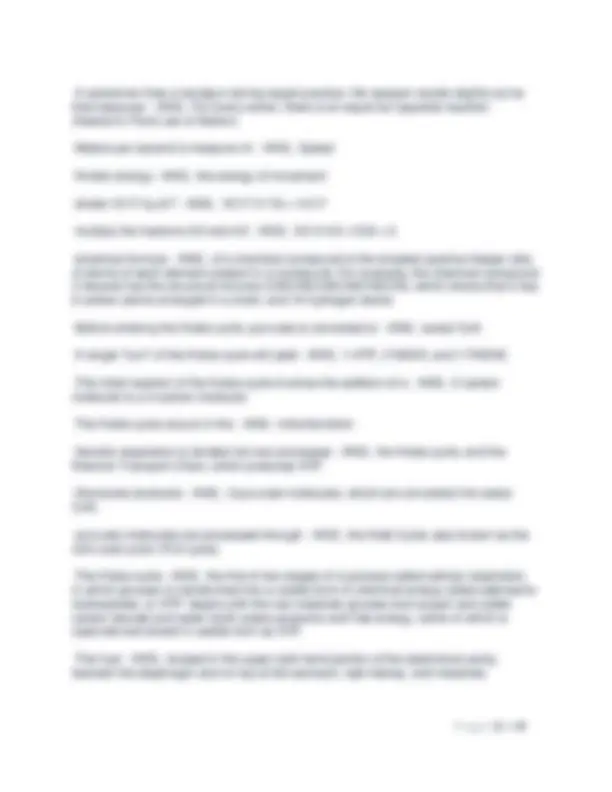
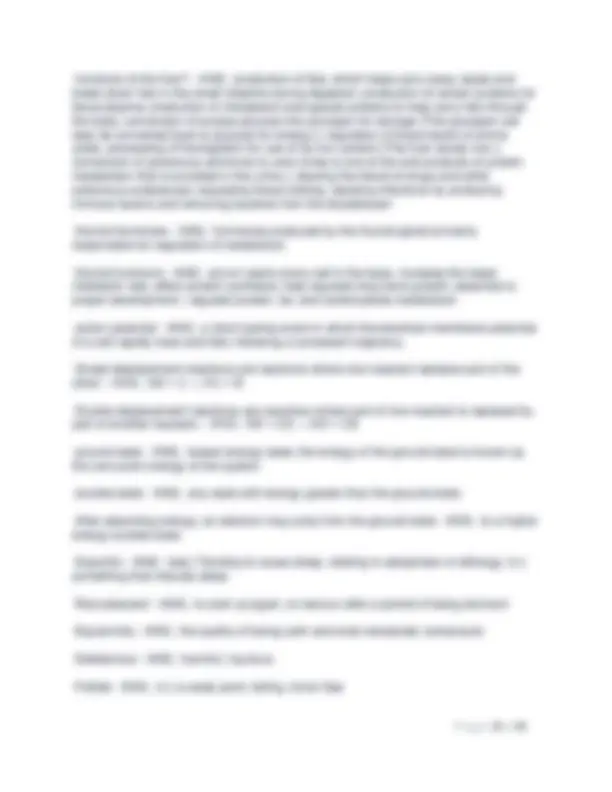
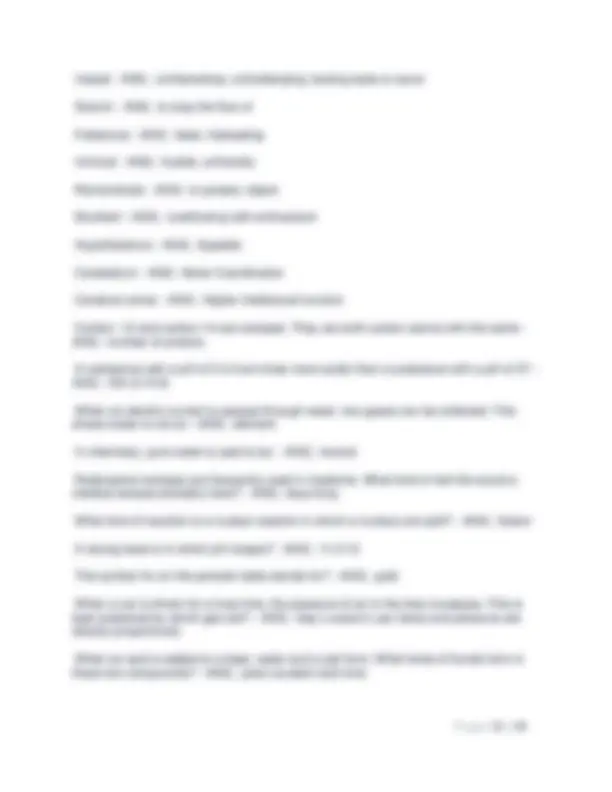

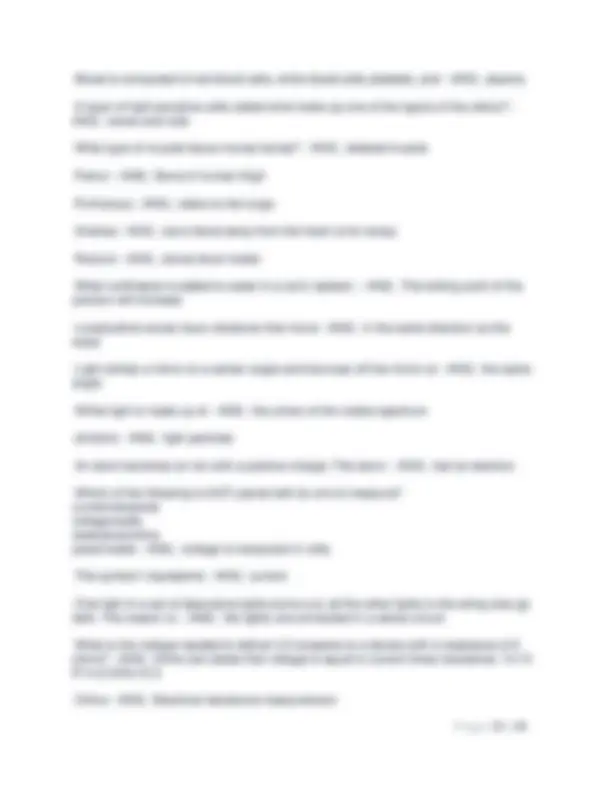
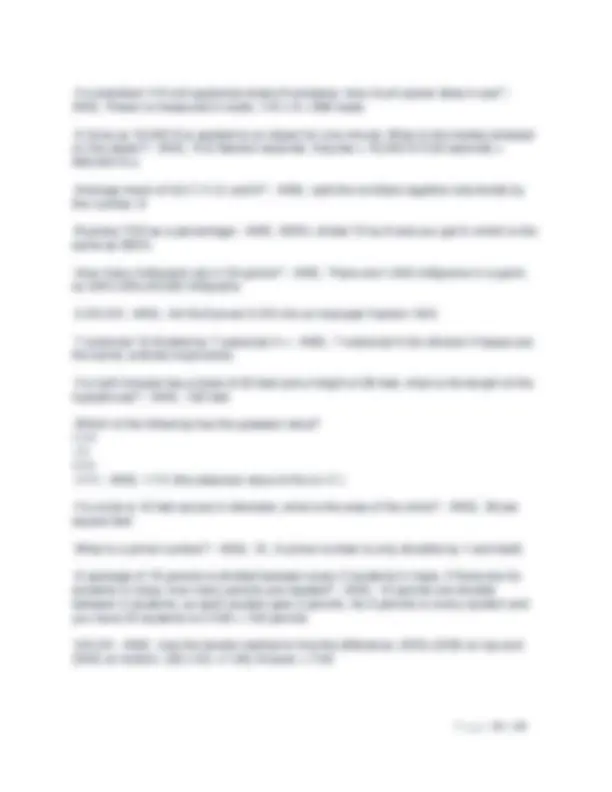
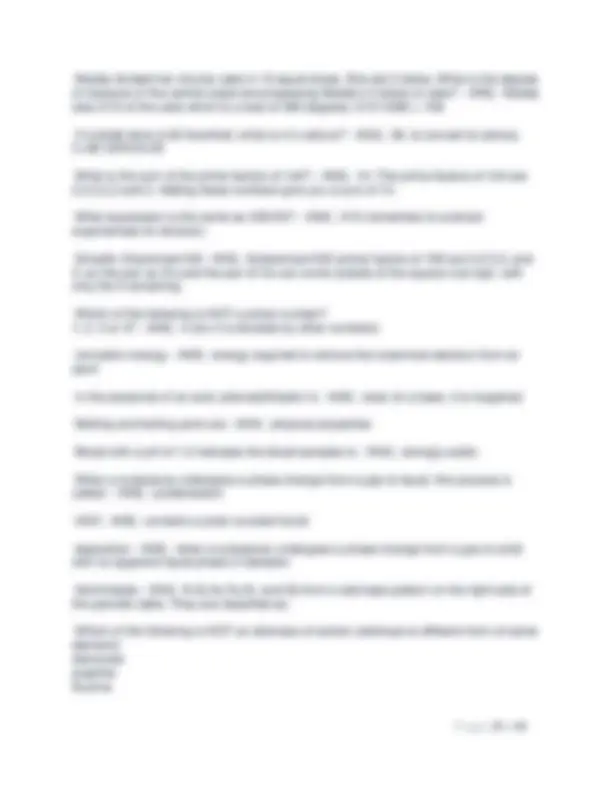

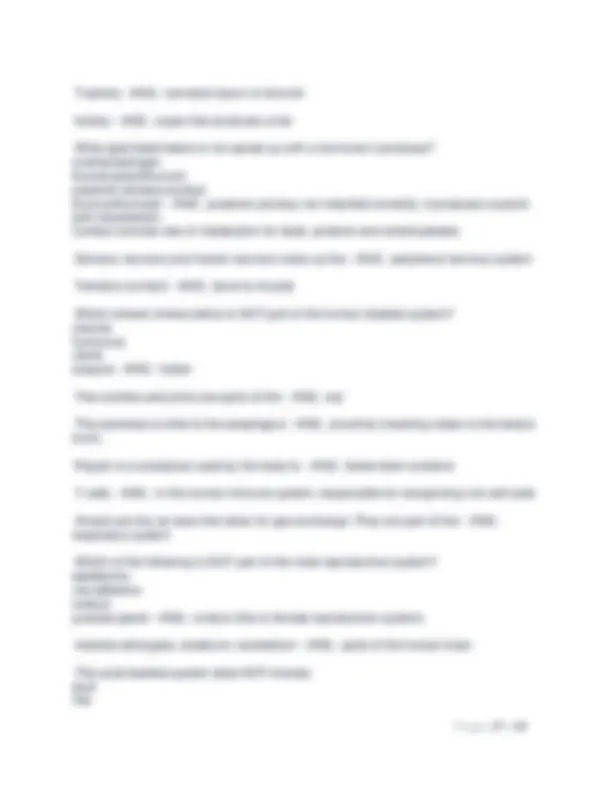
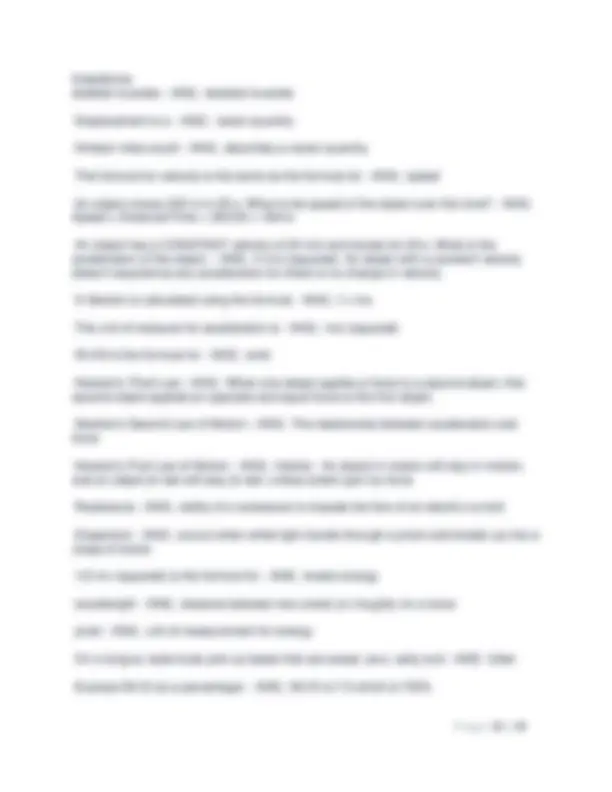
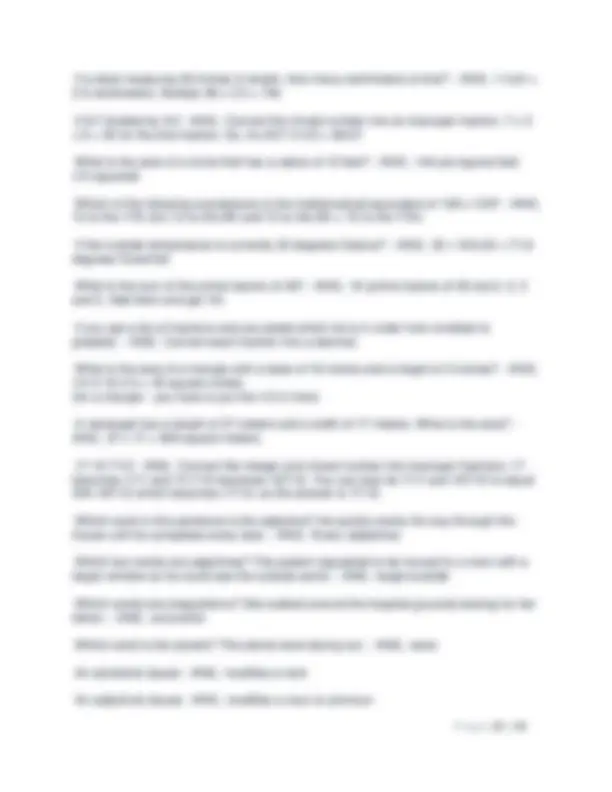
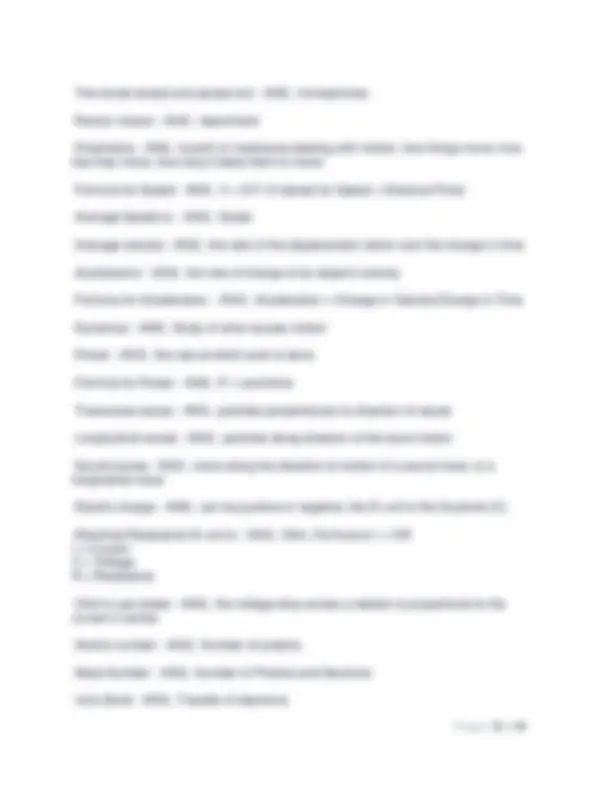
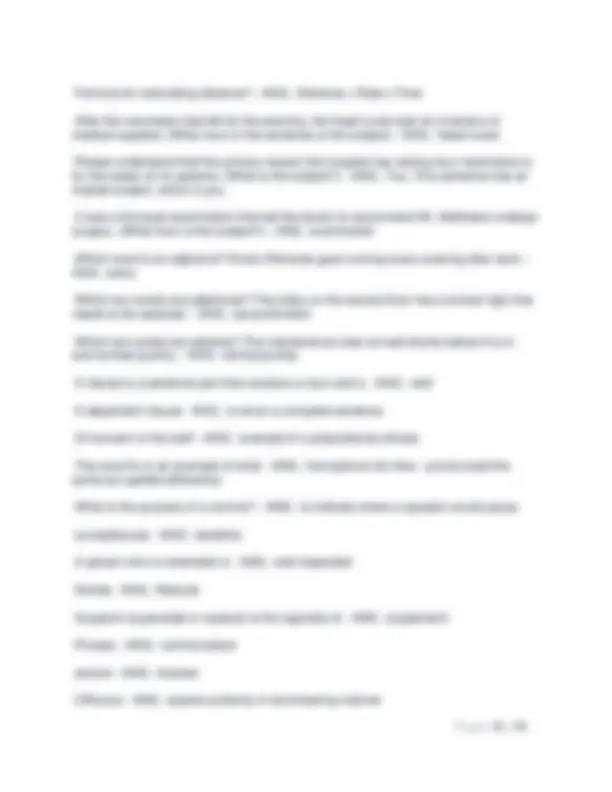
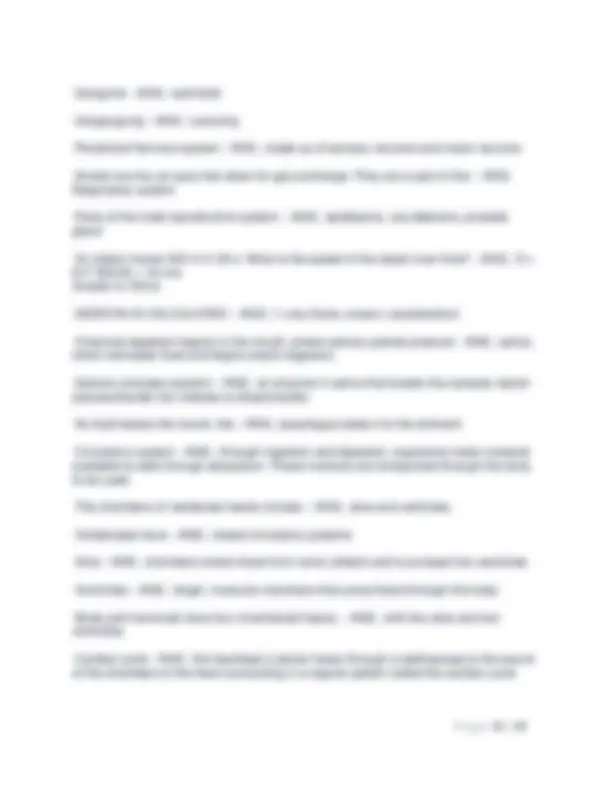
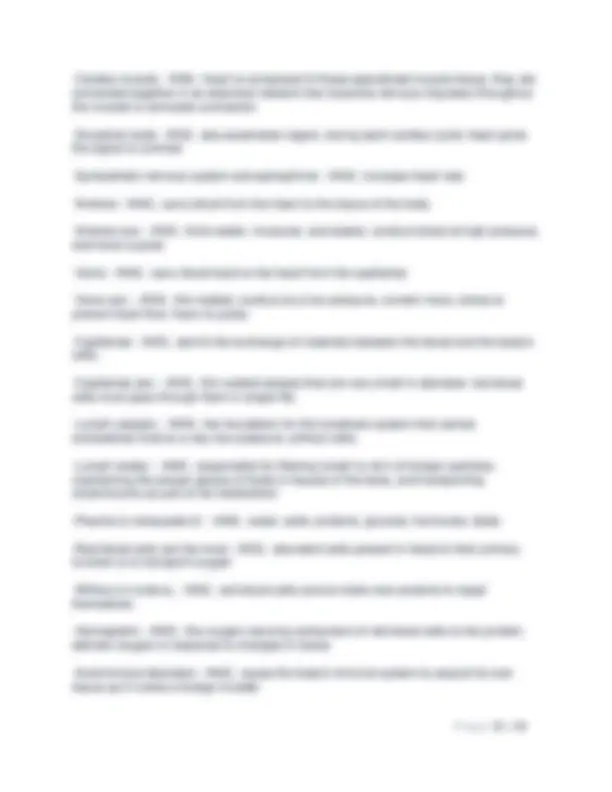
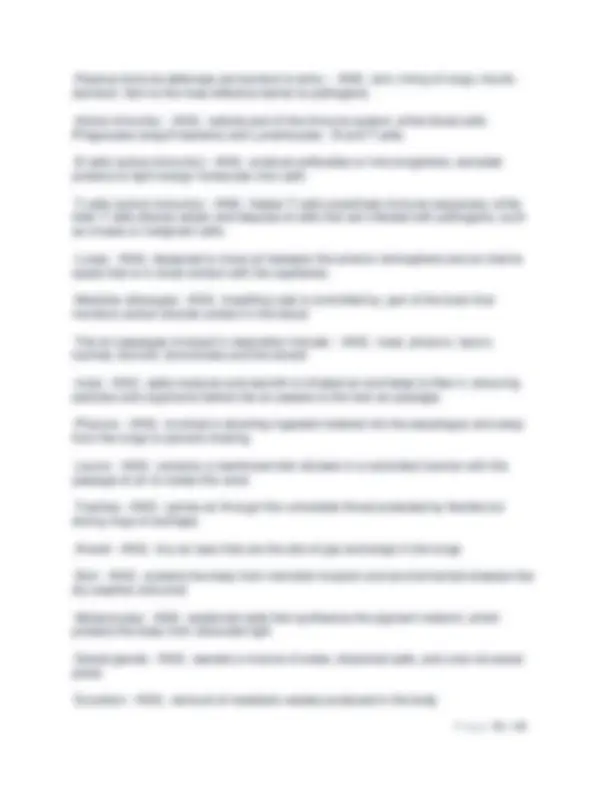
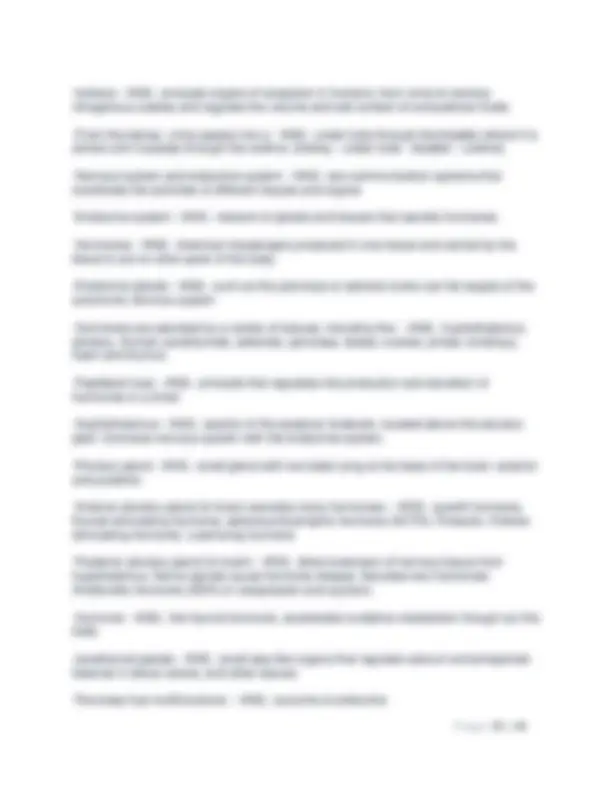
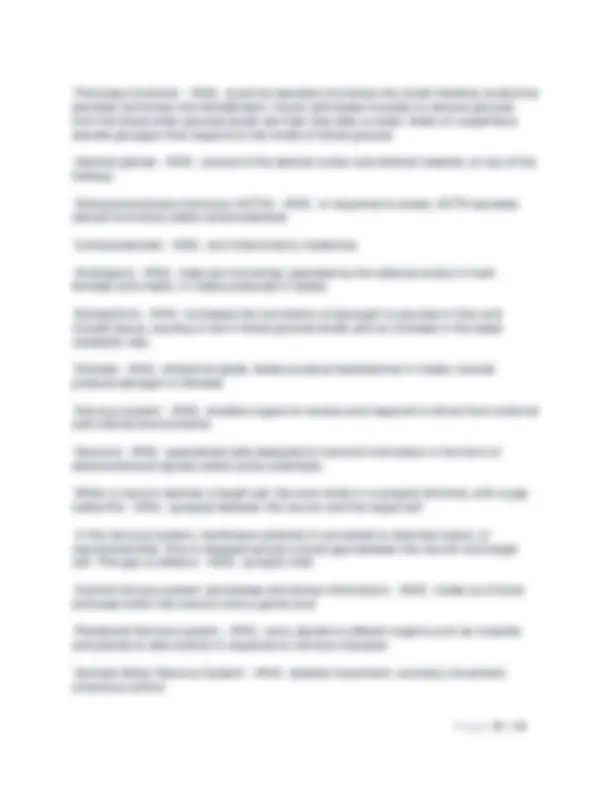
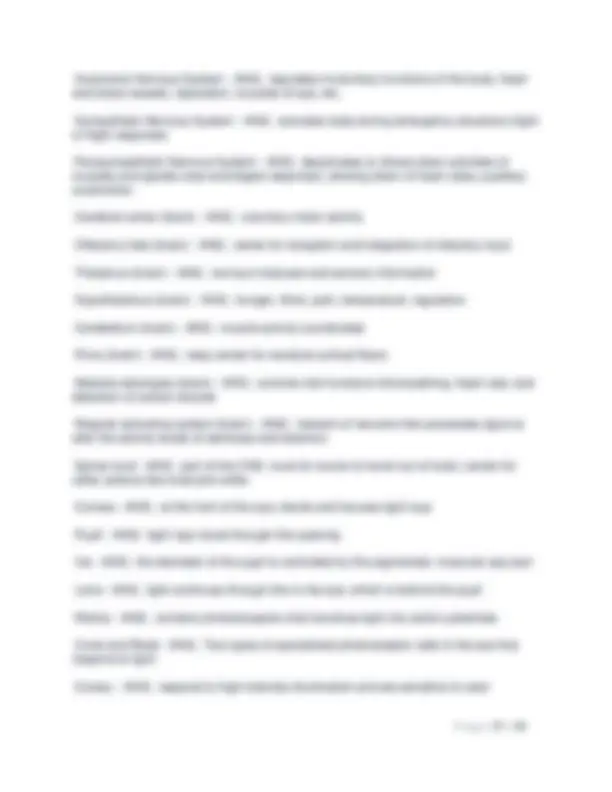
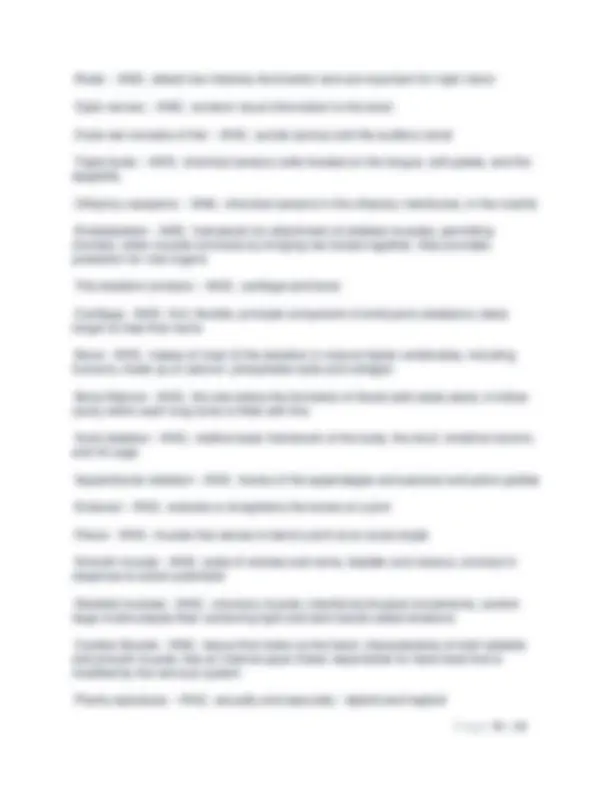
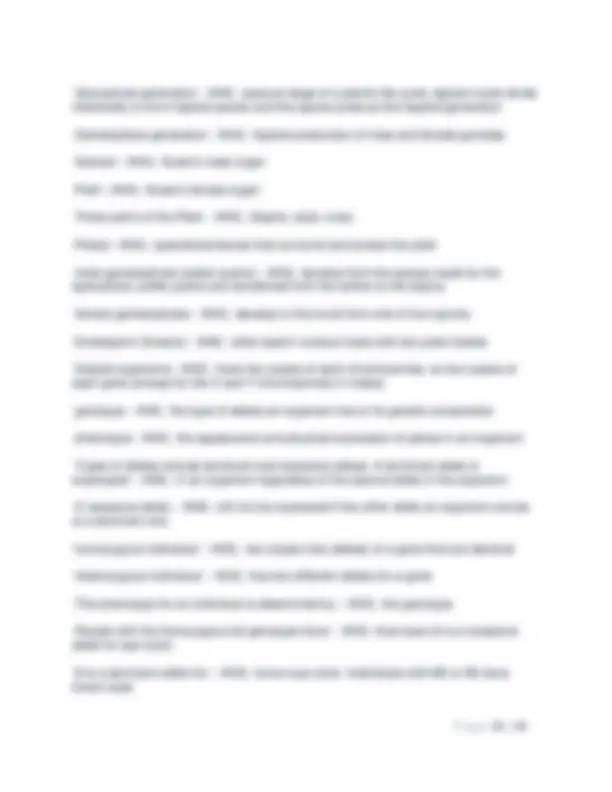
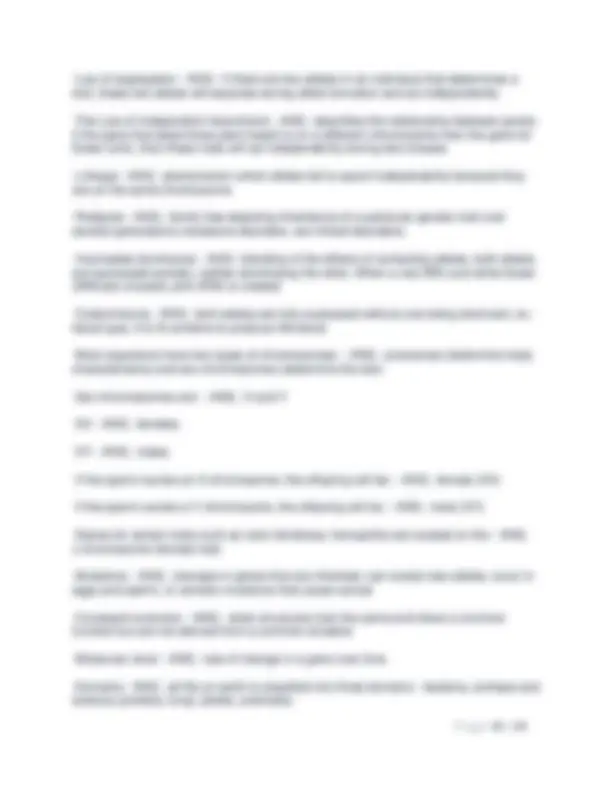

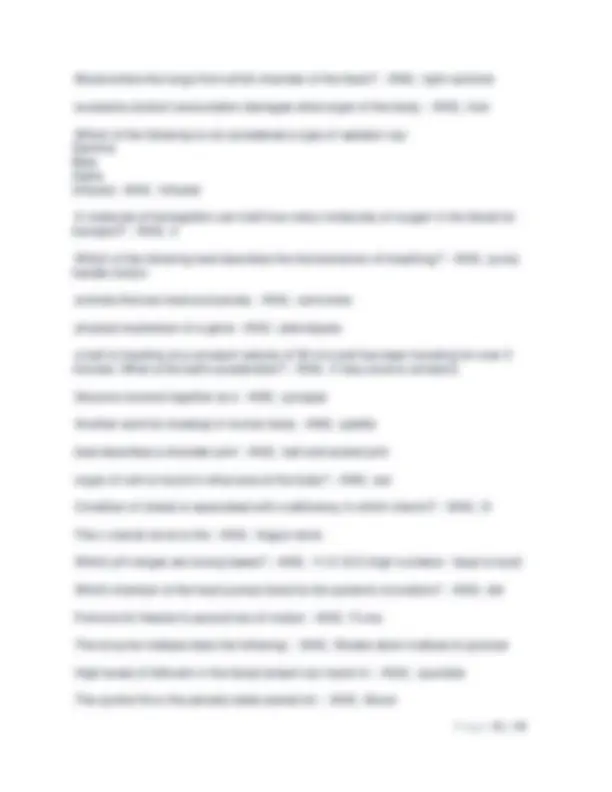
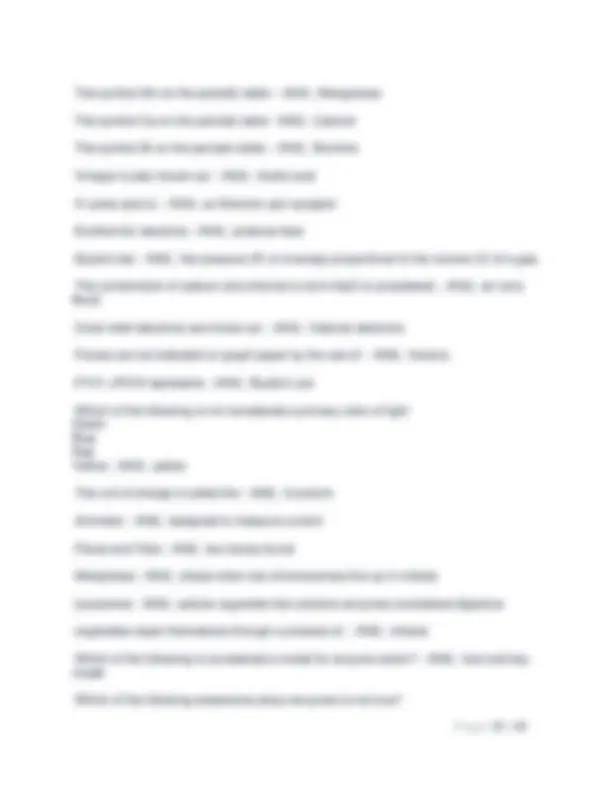
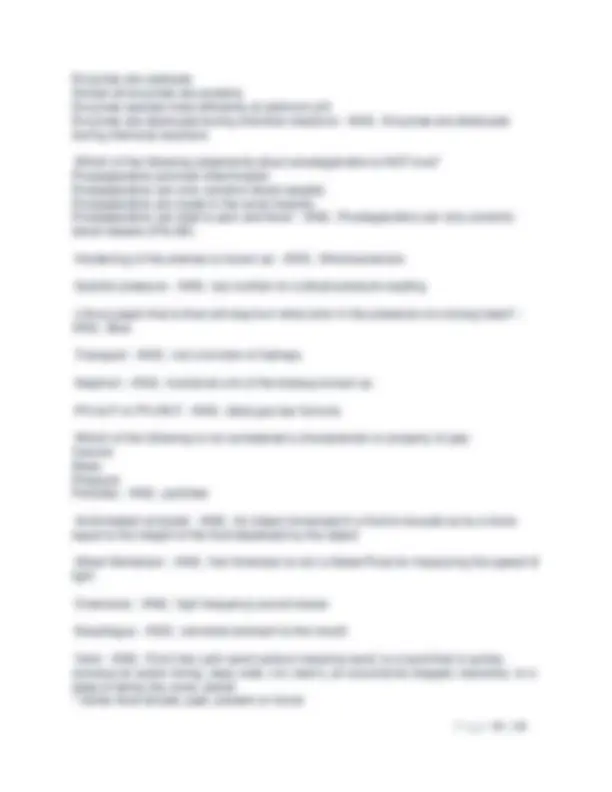
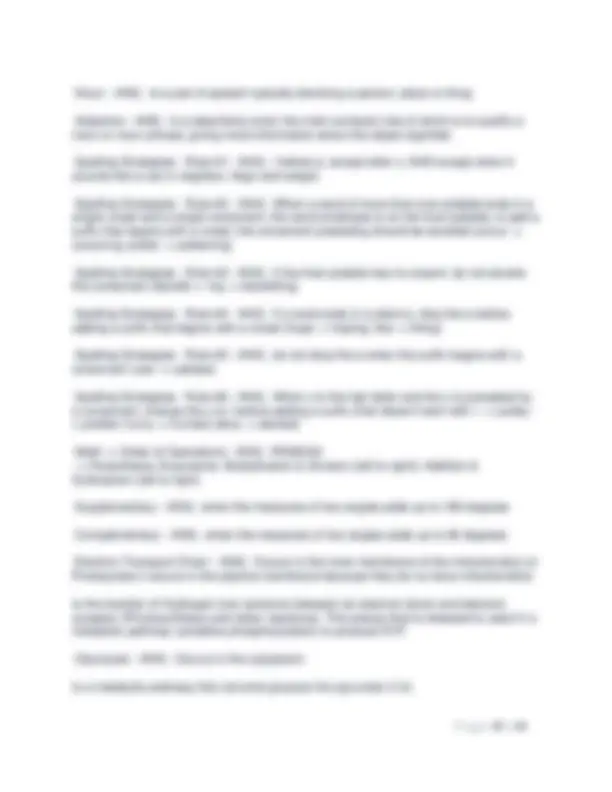
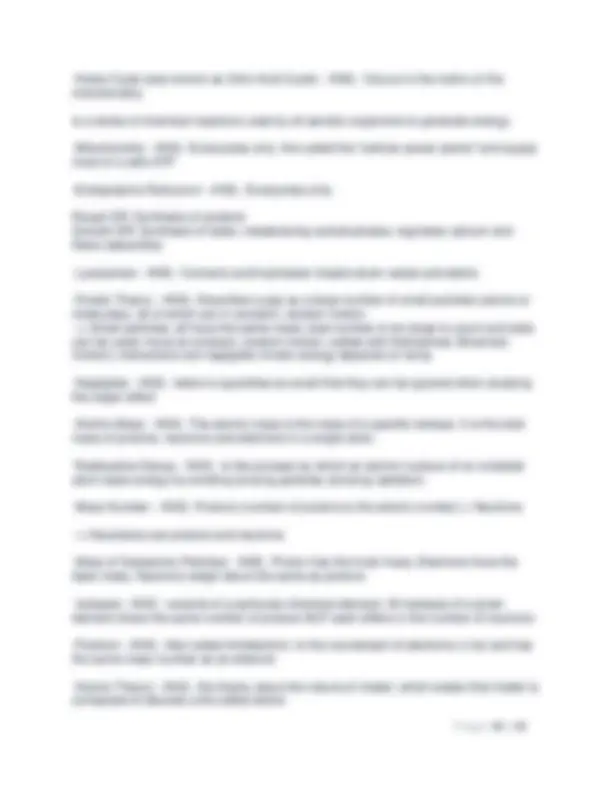
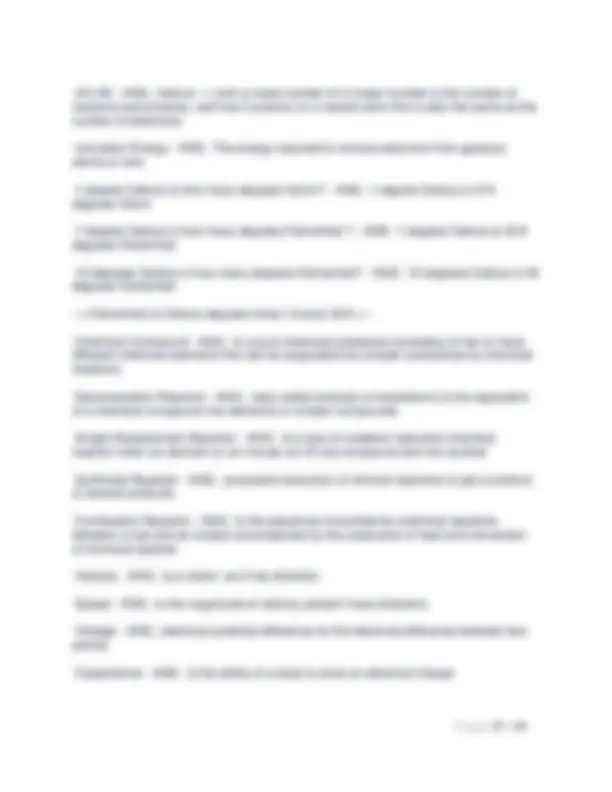
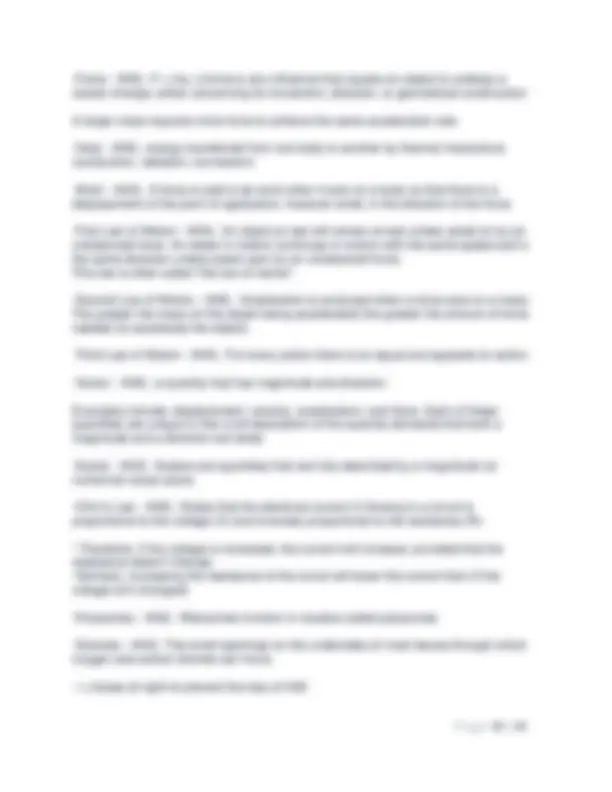
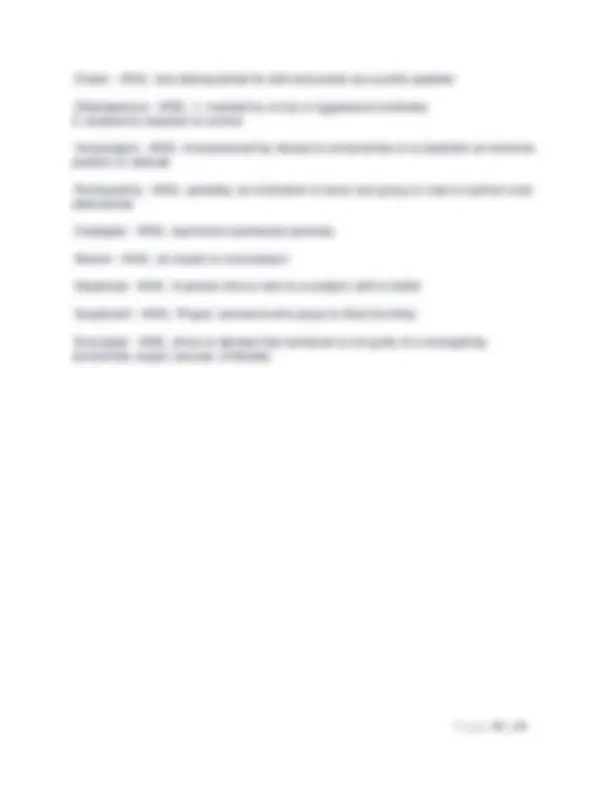


Study with the several resources on Docsity

Earn points by helping other students or get them with a premium plan


Prepare for your exams
Study with the several resources on Docsity

Earn points to download
Earn points by helping other students or get them with a premium plan
Community
Ask the community for help and clear up your study doubts
Discover the best universities in your country according to Docsity users
Free resources
Download our free guides on studying techniques, anxiety management strategies, and thesis advice from Docsity tutors
A collection of answers to various questions related to human anatomy and physiology. Topics covered include organs such as the pancreas and the knee joint, nervous system components like the sinoatrial node and the sympathetic and parasympathetic nervous systems, muscles such as cardiac muscle and smooth muscle, and reproduction processes like meiosis and fertilization. This document can be useful for university students studying biology or related fields.
Typology: Exams
1 / 49

This page cannot be seen from the preview
Don't miss anything!










































Which are correctly related: - ANS; Cardiac muscle:Involuntary action Which of the following associations of brain structure and function is false? Hypothalamus: Appetite Cerebellum:Motor Coordination Cerebral cortex: Higher intellectual function Medulla: Basic emotional Drive - ANS; Medulla: Basic emotional drives (false) Which of the following is not a characteristic of fermentation: It is anaerobic It requires glucose It produces energy It requires oxygen - ANS; It requires oxygen Which order of classificatory divisions is correct: - ANS; Phylum, class, order, genus King Phillip came over for great spaghetti The notochord is: - ANS; Present in chordates during embryonic development The absorption of oxygen from the atmosphere into the blood takes place in the: - ANS; Alveoli Enzymes in human cells: - ANS; Are proteins, typically work best at pH 7. Which is NOT a characteristic of proteins: They contain genetic information They can act as hormones They can catalyze chemical reactions They act in cell membrane trafficking - ANS; They contain genetic information Which part of cellular respiration directly produces a pH gradient during the oxidative metabolism of glucose? - ANS; Electron transport chain The Atomic Theory could be used to analyze: - ANS; Properties of hydrogen As you move from left to right across a period (horizontal row) in the periodic table: - ANS; The number of electrons is one more than the previous element
Ionization energy is: - ANS; The energy required to completely remove an electron from an atom or ion. Evaporation can best be described as: - ANS; the process in which molecules may have enough energy to leave the liquid phase and escape into the gaseous phase. If the half-life of a certain isotope is 5 years, what fraction of a sample of that isotope will remain after 15 years? - ANS; 1/ Which of the following represents 1 amu? a. 1.66 x 10 - 24 g b. 1.66 x 10 - 24 kg c. Neither a or b are correct d. Both a and b are correct - ANS; d. both a and b are correct Force exists only: - ANS; In pairs Speed is different from velocity because: Speed is a scalar quantity, and velocity is a vector quantity Velocity involves speed and direction Speed only expresses a magnitude All of the above are correct - ANS; All of the above are correct Whenever a current passes through a resistance, what is generated? - ANS; heat While attempting to push a heavy box across the floor: The amount of force required to start the box sliding is more than that required to keep it sliding. Pushing on the box without moving it results in no work being done. The coefficient of static friction is dependent on the nature of the surface the box is resting on. All of the above. - ANS; All of the above. A larger mass requires what force to achieve the same acceleration rate. - ANS; More A vehicle travels at a constant speed on the highway. It can be said that: Its acceleration rate is zero. The net forces acting on the vehicle are zero. The force applied by the vehicle's drive wheels is equal and opposite to the forces that act to slow the vehicle. All of the above are correct. - ANS; All of the above are correct. Vector quantities express: - ANS; Magnitude and direction. All of the following statements about force are true EXCEPT:
Virtuoso is the opposite of: - ANS; Incompetent Polarize is the opposite of: - ANS; Unite Whimsical is the opposite of: - ANS; Grave Dandy is the opposite of: - ANS; Careless dresser Mar - ANS; To damage, especially in a disfiguring way, to make something less attractive Mar is the opposite of: - ANS; Enhance Disperse is the opposite of: - ANS; Gather Hamper is the opposite of: - ANS; Assist Aptitude means the opposite of: - ANS; Inability Gullible means the opposite of: - ANS; Incredulous Replenish is the opposite of: - ANS; Deplete Abundant is the opposite of: - ANS; Scarce Wary means the opposite of: - ANS; Careless Sedentary means the opposite of: - ANS; Active Rudimentary is the opposite of: - ANS; Advanced Convoke - ANS; to call together Convoke is the opposite of: - ANS; Disperse Shard:Glass:: - ANS; Scrap:Quilt Filter:Impurity:: - ANS; Expurgate:Obscenity Cut:Laceration - ANS; Slit:Gap Quixotic - ANS; impractical Realist:Quixotic (a realist is the opposite of a quixotic) - ANS; Tormenter:Sympathetic Badge:Policeman (this identifies the policeman) - ANS; Dog tag:Soldier
Beseech - ANS; to request with great fervor Scrutinize:Observe - ANS; Beseech:Resquest Epicurean - ANS; Devoted to the pursuit of pleasure Indulge:Epicurean (someone Epicurean is likely to indulge themselves) - ANS; Revenge:Vindictive Stare:Look (a stare is a more intense form of looking) - ANS; Despair:Worry Pancreas:Organ (a pancreas is a type of organ) - ANS; Knee:Joint Enunciate (pronoune more clearly):Pronounce - ANS; Elaborate:Explain (Elaborate - discuss something in depth) Meander - ANS; to wander aimlessly Prattle - ANS; meaningless sounds, babble Meander:Walk - ANS; Prattle:Talk Diluvial - ANS; before the flood Flood:Diluvial - ANS; Heart:Cardiac (Cardiac is having to do with the heart) Penitent - ANS; person who tends to regret Querulous - ANS; complainer, argumentative Pentitent:Regret - ANS; Querulous:Quibble Vegetate:Active - ANS; Accept:Questioning Debilitate:Weak (to debilitate means to make weak) - ANS; Empower:Strong Advice or Advise - ANS; Advice Which of the following is $53,298 rounded off to the nearest 100? - ANS; 53, Accept - ANS; to take or receive Except - ANS; leave out
Reign - ANS; to exercise power Rein - ANS; a means or restraint or guidance; to restrain control. Integers - ANS; whole numbers, including negative and zero Ionization energy - ANS; The energy required to completely remove an electron from an atom or ion. Ionization energy increases from - ANS; left to right across a period as the atomic radius decreases. Electron affinity - ANS; the energy released when an electron is added to a gaseous atom. Represents the ease with which an atom can accept an electron. Electronegativity - ANS; a measure of the attraction an atom has for electrons in a chemical bond Atomic mass - ANS; number of protons mass number - ANS; number of protons and neutrons Ionic bond - ANS; transfer of electrons Covalent bond - ANS; sharing of electrons solute - ANS; substance being dissolved (often solid) Solvent - ANS; substance doing the dissolving (often liquid) solution - ANS; solvent and dissolved solute Arrhenius - ANS; an acid as a species that produces H+ in an aqueous solution, and a base as a species that produces OH- in aqueous solution A Bronsted-Lawry acid - ANS; species that donates protons Bronsted Lawry base - ANS; species that accepts protons A Lewis acid - ANS; electron-pair acceptor Lewis base - ANS; electron-pair donor Mass - ANS; measure of the amount of substance in an object, kg Weight - ANS; gravitational force pulling down an object, measured in Newtons (N)
Heat - ANS; Kinetic energy of molecules transferred from a warmer substance to a cooler one. Temperature - ANS; measure of the average kintetic energy of molecules in a substance Fusion - ANS; combining of small nuclei into larger ones, releasing energy Fission - ANS; splitting of large nucleus into smaller ones, with the release of neutrons and energy. Compound - ANS; a pure substance that is composed of two or more elements in a fixed proportion The elements in the periodic table may be classified into three categories - ANS; Metals, nonmetals and metalloids Three types of subatomic particles - ANS; protons, neutrons, electrons The periodic table arranges elements in - ANS; increasing atomic numbers The law of charges states that - ANS; like charges repel each other and unlike charges attract each other Heat - ANS; the kinetic energy of molecules transferred from a warmer substance to a cooler one Transverse wave - ANS; a wave that vibrates in a direction that is perpendicular to the direction of motion of the wave Longitudinal wave - ANS; a wave that vibrates in a direction that is parallel to the direction of motion of the wave All that apply to a sound wave - ANS; It is a longitudinal wave, it is a mechanical wave The kinetic molecular theory: Gases are made up of particles whose volumes are - ANS; negligible compared to the container volume The kinetic molecular theory: Gas atoms or molecules exhibit no - ANS; intermolecular attractions or repulsions The kinetic molecular theory: Gas particles are - ANS; in continuous, random motion, undergoing collisions with other particles and with the container walls.
Eukaryotic cells - ANS; humans, trees, mushrooms, and all protists (amoebas or paramecia), Mitochondria - ANS; sites of aerobic respiration within the cell and important suppliers of energy (ATP) Powerhouse of the cell Cyokinesis - ANS; when the cytoplasm splits into two after the mitosis is completed The air passages involved in respiration consist of: - ANS; the nose, pharynx, larynx, trachea, bronchi, bronchioles, and alveoli. Three types of muscle tissue in vertebrates: - ANS; smooth, skeletal and cardiac The law of segregation states: - ANS; if there are two alleles in an individual that determine a trait, these two alleles will separate during gamete formation and act independently Species - ANS; a group of organisms that is able to successfully interbreed with each other and not other organisms Cell membrane (plasma membrane) - ANS; encloses the cell, regulates the passage of materials into and out of the cell. Eukaryotic cells differ from prokaryotes because they contain - ANS; organelles, membrane-bound structures that carry out specific functions for the cell. Organelles include the nucleus, endoplasmic reticulum, Golgi, lysosomes, vacoules, mitochondria, etc. Cytoplasm - ANS; liquid inside a cell that surrounds organelles, gives the eukaryotic cell shape Prokaryotes - ANS; unicellular organisms Cell wall - ANS; is the outside lining that holds cell together. Cell membrane - ANS; is covered by the cell wall. Cell membrane is a semi-permanent substance so substances can pass through it, also known as plasma membrane or plasma lemma. CHROMOSOME - ANS; DNA of organism, structure in a cell that contains DNA CYTOPLASM - ANS; Described as the cytosol, largely composed of water. FUNGI - ANS; Single celled nun-nucleated microorganisms
GENE - ANS; segment of DNA that functions as a unit GENOMICS - ANS; Study of genes, diagnose disease before tissue damaged LIPID - ANS; Water insoluble compound MICROTUBLE - ANS; Protein structure that gives cell its shape MOLECULE - ANS; Two or more atoms combine NUCLEOTIDE - ANS; 3-carbon and sugar base PLASMID - ANS; Small circular independently replicating piece of DNA can transfer to another cell (in bacteria, it is extra) PRIMERS - ANS; starting point for DNA synthesis, short structures of nucleotides POLYMERASE CHAIN REATION (PCR) - ANS; Need DNA to be amplified (multiplied) PORES - ANS; the nuclear envelope has PORES on its surface to allow larges molecules such as mRNA to enter. Mitosis - ANS; N-N, 2N-2N, Eukaryotic Cells, Identical #, Haploid-Haploid, Diploid- Diploid, Can create replication errors, type of mutation and cancer results Meiosis - ANS; 2N-N, ½ # chromosomes, Only in testes/ovaries, Reproduce Sexually, Gametes Human male reproduce system produces sperm in the - ANS; testes Testes - ANS; Gonads located in an out pocketing of the abdominal wall called the scrotum Seminiferous tubules - ANS; sperm develop in those series of small, coiled tubes within the testes Leydig cells - ANS; make up the testosterone that supports male secondary sex characteristics Vas deferens - ANS; carry sperm to the urethra that passes through the penis Prostate gland and seminal vesicles - ANS; during ejaculation, add secretions to the sperm that carry and provide nutrients for the sperm as part of semen Function of the testes - ANS; produce sperm and male hormones (testosterone)
population - ANS; a group of organisms of the same species that live in a specific geographical area and interbreed phenotype - ANS; physical expression of inherited traits alleles - ANS; Different forms of a gene. Example height (tall or short) in pea plants. Gene pool - ANS; the sum total of all alleles (different forms of a gene) in a population Allele frequency - ANS; the frequency with which a specific allele appears in a gene pool Variation in genotypes and phenotypes - ANS; each individual receives its specific sets of alleles from the gene pool, and not every individual receives the same alleles Mutation in a population - ANS; creates new alleles Evolution is caused by - ANS; changes in the gene pool of a population over time, and changes to alleles Species - ANS; group of organisms that is able to successfully interbreed with each other to produce fertile offspring and not with other organisms Reproductive isolation - ANS; in biological species, in inability to interbreed and create fertile offspring (dogs only breed with other dogs, etc) Spermatogenesis is characterized by: - ANS; production of four mature sperm; each sperm has an X or Y chromosome; the process is continuous; Fresh sperm are created daily Oogeneisis is characterized by: - ANS; production of one egg and two to three polar bodies; only ova with X chromosomes produced; the process is discontinuos; ova are produced that donate mitochondria to embroyos; a limited supply of ova is produced early in life and the development of ova is arrested later in life Right ventricle - ANS; pumps blood to the lungs into the pulmonary artery Left ventricle - ANS; pumps blood through the aorta to the rest of the body Arteries functions and characteristics: - ANS; thick walled; oxygenated; conduct blood at high pressures; have a pulse; no valves to prevent backflow Veins - ANS; thin walled; deoxygenated; conduct blood at low pressures; no pulse; have valves to prevent backflow
Sympathetic nervous system - ANS; associated with fight or flight response; increases heart rate; increases breathing rate; lowers digestive rate; causes pupil dilation Parasympahtetic nervous system - ANS; associated with rest-and-digest response; lowers heart rate; no affect on breathing rate; increases digestive rate; doesn't cause pupil dilation Cones - ANS; photoreceptors that respond to high-intensity illumination and color Rods - ANS; respond to low-intensity illumination (important in night vision), but do not detect color well Smooth muscle - ANS; involuntary muscle present in the arteries, gastrointestinal tract, and elsewhere Skeletal muscles - ANS; voluntary muscles that cause body movement Cardiac muscle - ANS; tissue that makes up the heart Incomplete dominance - ANS; when two traits are blended together; both are partially expressed, and neither dominates Codominance - ANS; both traits are fully expressed and neither dominates Homologous structures - ANS; share a common ancestry Analogous structures - ANS; not inherited from a common ancester, but perform similar functions The population in a community interact with each other in a variety of ways, including - ANS; predation, competition, or symbiosis Predation - ANS; the consumption of one organism by another, usually resulting in death Competition - ANS; a competitive relationship usually exists in a population when there are limited resources Symbionts - ANS; live together in an intimate, often permanent, association that may or may not be beneficial to them Write the taxonomic classifications in order - ANS; Domain, Kingdom, Phylum, Subphylum, Class, Order, Family Genus, Species (Does King Phillip Sometimes Come Over for great Spaghetti?)
Tough elastic tissues found in the joints that connect bones are called - ANS; Ligaments Marsupial mammals differ from placental mammals in that - ANS; Marsupials bear premature embryos that complete development in their mother's pouches Rods and cones are light-sensitive cells inside the eyes: - ANS; Retina Muscles controlled by conscious thought - ANS; Straiated Ecology - ANS; study of interactions between organisms and their relationships with their environments Most of the nutrients in food are absorbed in the body's - ANS; small intestine carbohydrates include - ANS; starches and sugars Chordata - ANS; Phylum that includes man Which statement regarding protein synthesis is false? tRNA molecules help incorporate the correct amino acids into proteins. Proteins are formed on the ribosomes. mRNA is not necessary for proper protein synthesis. Ribosomal RNA is needed for proper binding of the mRNA message. - ANS; This is False: mRNA is not necessary for proper protein synthesis - protein synthesis does require mRNA. A typical human gamete: - ANS; contains a haploid number of genes; will always contain an X or Y chromosome; has undergone genetic recombinations In humans, red blood cells: - ANS; have no nucleus (red blood cells are made in the bone marrow, they lose their nuclei to make room for hemoglobin, so they cannot reproduce or repair themselves) What best describes tRNA? - ANS; Binds specific amino acids and carries them to the ribosomes during protein synthesis (taxi) Which statement about human gamete production is false? In the testes, sperm develop in the seminiferous tubules. In the ovaries, eggs develop in the ovarian follicles. FSH stimulates gamete production in both sexes. The result of meiosis in females is the production of 4 egg cells from each diploid precursor cell. - ANS; The production of 4 eggs is false - Oogenesis produces only one viable egg and two or three polar bodies.
If a diabetic accidentally overdosed on insulin, which of the following would be likely to occur? - ANS; Increased conversion of glucose to glycogen. Saliva in the mouth begins the process of breaking down: - ANS; starch Spermatogenesis and oogenesis differ in that: - ANS; Meiosis proceeds continually without pausing in spermatogenesis and oogenseis involves a meiotic pause. Spermatogenesis produces 4 haploid sperm cells from each diploid precursor cell, while oogenesis produces one egg cell and two or more polar bodies. An individual that has only one X chromosome is genotypically XO. This person - ANS; Will be phenotypically female but sterile (turner's female) underdeveloped ovaries, may be shorter with mental development problems) The first organisms on earth were thought to be: - ANS; Heterotrophs In an emergency, a person with type AB antigen in his red blood cells may receive a transfusion of: - ANS; Type O, A or B (Type AB is a Universal acceptor) Function of hormone progesterone - ANS; Prepares the uterus for implantation of the fertilized egg The gene for color blindness is X-linked. If normal parents have a color blind son, what is the probability that he inherited the gene for color blindness from his mother? - ANS; 100% (the mother has two X chromosomes, one from her mother and one from her father and the father only has one X chromosome from his father, so his mother MUST be the carrier) What is a chemical process: - ANS; Iron forms rust In degrees kelvin, the freezing point of water is: - ANS; 273 An atom that is not electrically neutral is called - ANS; an ion The atom of an element with an atomic number of 17 must have: - ANS; 17 electrons The sun's core consists primarily of 1H and 4He, as well as various other trace elements and isotopes. Which of the following statements is not true regarding the fusion reaction that occurs within the core? Electrons are released as a product of the fusion reaction. The mass of the products is less than the mass of the reactants in the balanced fusion equation. Six photons are emitted as a product of the fusion reaction. Four hydrogen atoms combine to form a single helium atom. - ANS; Not true - Electrons are released as a product of the fusion reaction (the core of the sun is so hot, the electrons are stripped away)
A policeman fires a handgun during target practice. His weapon recoils slightly as he fires because: - ANS; For every action, there is an equal but opposite reaction. (Newton's Third Law of Motion) Meters per second is measure of: - ANS; Speed Kinetic energy - ANS; the energy of movement divide 12/17 by 6/7 - ANS; 12/17 X 7/6 = 14/ multiply the fractions 3/2 and 4/3 - ANS; 3/2 X 4/3 =12/6 = 2 empirical formula - ANS; of a chemical compound is the simplest positive integer ratio of atoms of each element present in a compound. For example, the chemical compound n-hexane has the structural formula CH3CH2CH2CH2CH2CH3, which shows that it has 6 carbon atoms arranged in a chain, and 14 hydrogen atoms Before entering the Krebs cycle, pyruvate is converted to - ANS; acetyl-CoA A single "turn" of the Krebs cycle will yield - ANS; 1 ATP, 3 NADH, and 1 FADH2. The initial reaction of the Krebs cycle involves the addition of a - ANS; 2-carbon molecule to a 4-carbon molecule. The Krebs cycle occurs in the - ANS; mitochondrion Aerobic respiration is divided into two processes - ANS; the Krebs cycle, and the Electron Transport Chain, which produces ATP Glycolysis produces - ANS; 2 pyruvate molecules, which are converted into acetyl CoA, pyruvate molecules are processed through - ANS; the Kreb Cycle, also known as the citric acid cycle (TCA cycle) The Krebs cycle - ANS; the first of two stages of a process called cellular respiration, in which glucose is transformed into a usable form of chemical energy called adenosine triphosphate, or ATP. begins with the raw materials glucose and oxygen and yields carbon dioxide and water (both waste products) and free energy, some of which is captured and stored in usable form as ATP. The liver - ANS; located in the upper right-hand portion of the abdominal cavity, beneath the diaphragm and on top of the stomach, right kidney, and intestines
functions of the liver? - ANS; production of bile, which helps carry away waste and break down fats in the small intestine during digestion; production of certain proteins for blood plasma; production of cholesterol and special proteins to help carry fats through the body; conversion of excess glucose into glycogen for storage (This glycogen can later be converted back to glucose for energy.); regulation of blood levels of amino acids, processing of hemoglobin for use of its iron content (The liver stores iron.); conversion of poisonous ammonia to urea (Urea is one of the end products of protein metabolism that is excreted in the urine.); clearing the blood of drugs and other poisonous substances; regulating blood clotting; resisting infections by producing immune factors and removing bacteria from the bloodstream thyroid hormones - ANS; hormones produced by the thyroid gland primarily responsible for regulation of metabolism thyroid functions - ANS; act on nearly every cell in the body. increase the basal metabolic rate, affect protein synthesis, help regulate long bone growth; essential to proper development ; regulate protein, fat, and carbohydrate metabolism action potential - ANS; a short-lasting event in which the electrical membrane potential of a cell rapidly rises and falls, following a consistent trajectory. Single displacement reactions are reactions where one reactant replaces part of the other. - ANS; AB + C → AC + B Double displacement reactions are reactions where part of one reactant is replaced by part of another reactant. - ANS; AB + CD → AD + CB ground state - ANS; lowest-energy state; the energy of the ground state is known as the zero-point energy of the system excited state - ANS; any state with energy greater than the ground state. After absorbing energy, an electron may jump from the ground state - ANS; to a higher energy excited state. Soporific - ANS; (adj.) Tending to cause sleep, relating to sleepiness or lethargy; (n.) something that induces sleep Recrudescent - ANS; to start up again, to reoccur after a period of being dormant Equanimity - ANS; the quality of being calm and even-tempered; composure Deleterious - ANS; harmful, injurious Folible - ANS; (n.) a weak point, failing, minor flaw